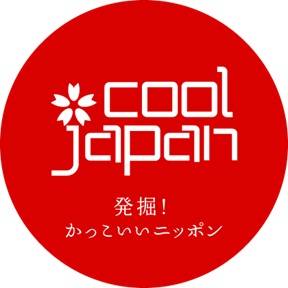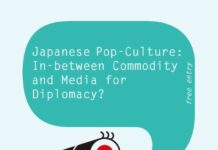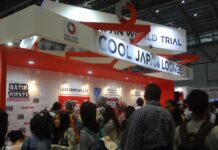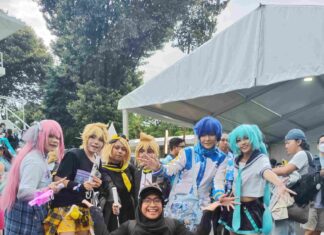HM: So, there are public diplomacy aspect related to Japan’s international image and also economic aspect. And in the economic aspect, there are domestic and international factors, right? To create more jobs domestically and to gain profit from sales of their products abroad?
BY: Correct. For the economic aspect, there are domestic and international factors. Domestically, this is one of the solutions for their slow growth in the job market. Creative sector is expected to push the creation of new jobs. Internationally, the variety of creative products can help Japan to enter broader and diverse markets throughout many countries and profit from them.
GAW: Is this Cool Japan, considering its political reason, a part of Japan’s attempts to broaden the foundation of their political implementations?
BY: Yes, that’s right. Japan has big ambitions in utilizing popular culture. In its diplomacy report in 2005, Japan mentioned its ambitions to present itself to the world as a peace-loving country and intend to be a permanent member of the UN Security Council.
The use of popular culture is as a means/media to spread and shape a positive image of Japan globally.
Perhaps the logic for this is that a country that actively produces and rich in culture is a peaceful country… perhaps.
GAW: I intend to seek a link to military moefication…. In strategic/security and defense context, of course, in which after 1997 they are fervently pursuing capacity building and facilitating dialogues in Southeast Asia. The additional factor -competition, I guess- being their conflicting position to People’s Republic of China’s claim/influence in the same region.
HM: For the so-called “military moe,” to my knowledge, they were initially just artistic creations without any links to government agenda. They were made by people who simply love such themes (such as Humikane Shimada of Strike Witches fame), or made as products marketed to people who like such themes. Only recently, there were cases such as the use of “moe” styled illustrations in recruitment posters for the Self-Defense Force. Or just recently there is collaboration between JMSDF (Japan Maritime Self-Defense Force) with the anime series Arpeggio of Blue Steel (Aoki Hagane no Arpeggio). But whether there is a deeper and strategic link beyond public relations stunt, I am not certain yet. How about Bagus?
BY: For moefication, I agree with Halimun. It’s more about the creator’s interest without any specific government agenda. But there is a possibility that the Japanese government plays some part by ‘permitting’ such themes to spread as unconscious or humorous message. Like, those moefication could indirectly show that Japan possesses firm military capability, but the moe effect gives an un-threatening vibe. But again, formally, there is no relation to government policy/agenda.
HM: That Kantai Collection managed to gain a broad player base, I heard from a KAORI staff that KanColle players, at least in Indonesia, mostly aren’t paying much attention to that game’s history aspect. Maybe they are interested only in the cute girls? How is it Aji? Does the answer suffice, or would you like to ask further questions?
GAW: So initially it’s still more towards niche market, huh. I’ll follow up later.
JL: Considering that the main purpose is “image-building” it is interesting that METI has begun to take on intellectual property rights issues on some anime and manga titles, particularly by giving licenses that actually hinders the “image-building” purpose of Cool Japan itself?

BY: Good. That’s an interesting question, Jochanan. There is a debate of course. Image-building, or monetization.
I think the Japanese government sees this in global/general context. Cool Japan is now under the auspices of METI. Therefore, we could assume that METI’s main focus is to ensure that Japan’s popular culture produces money. And piracy is seen as a leakage in profit. But on the other hand, the Japanese government still pursues public diplomacy through its culture.
What happened then? There is scroll to adjust. As long as they consider the damage to image-building purpose is not significant -for example, there are other cultural products that can be consumed without sacrificing intellectual property rights and licensing- they would stand firm on their aim to secure economic profit. One of METI’s grand plans for Cool Japan does concern the regulation of intellectual property rights and licensing. So, the economic consideration is strong.
As for image-building, as long as it doesn’t diminish the total popularity significantly, no problem. Remember, it’s about politics and government. Look at the macro aspect.
JL: Does Cool Japan actually contributed significantly in macro terms? It seems that the economic benefit of Cool Japan is still too small for Japan… While their popularity seems to depend on piracy…
HM: Keep in mind that, as Bagus has mentioned before, Cool Japan is not limited to just animation and comics.
JL: Indeed… I do still see it mainly on anime and comics. But even when it comes to music, or even gunpla (Gundam plastic models) there is the price issue. So, many fans still prefer to look for pirated or bootleg products… Which means they don’t make any profit for Japan… But they still support the popularity of Japan’s popular culture.
HM: Other than music, the products you mentioned are still tightly related to anime and manga culture, no?
How about what Bagus has to say?
BY: There are two main factors, Jochanan.
- As I have mentioned before, Cool Japan products comes from 18 different industries;
- Cool Japan products are spread to various countries.
As a whole, these are good safeguards to ensure profit for Japan.
As for anime, manga, and related products such as toys & merchandise, Japan aims for “otaku” or collectors. You could call them, middle-premium buyers.
Japan does not aim to make everyone from any background purchase those products. Japan has been aware of the existence of comics/DVD rent shops in ASEAN countries, the price of their merchandise are relatively expensive, etc. But I think Japan tries to avoid having a price war with China.
For example, you could buy a Chinese-branded Tamiya, but purchasing original TAMIYA products would give a different satisfaction. The same goes for other products. So, I think Japan has take into account marketing concept and analyze the growing middle-class market in Asia.
HM: All right, I have the next question. We already talked about the Japanese government’s involvement and agenda regarding Cool Japan. How about the role of the private/business/industry sectors themselves in Cool Japan promotion program?
BY: I observe that they tend to ride the wave. They’re observing whether the government’s involvement provides them incentive for expansion or not. So far, I don’t see specific complaints from private/business/industry sector. It seems to be supportive for them.
Though there were some criticisms accusing the Cool Japan agenda to only profit big corporations, as a whole, the private sector was not disturbed and it also provides them a chance to reach the broader global market. Creative industry to some extent does not limit the potential for overseas expansion to certain scale of enterprise. That means small and medium enterprises can also take their products abroad. So, the role of private/business/industry sector is to enrich the products of Cool Japan.







